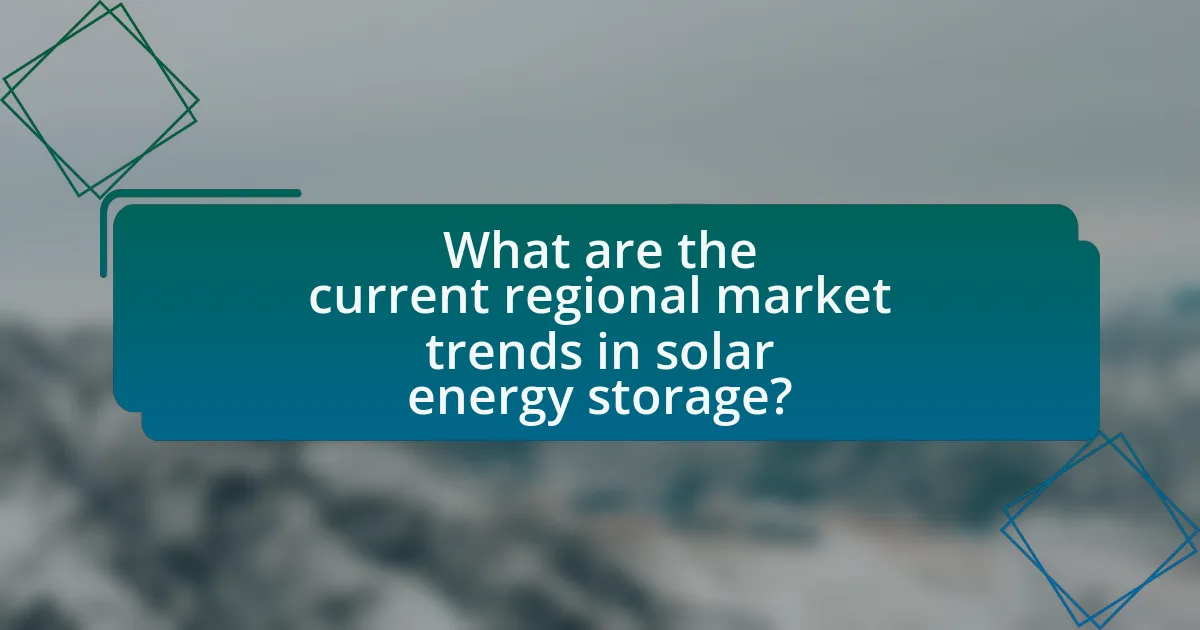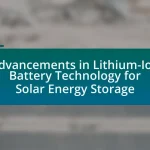The article focuses on the regional market trends in solar energy storage, highlighting significant growth in North America, Europe, and Asia-Pacific. It examines the factors influencing adoption rates, such as government policies, technological advancements, and economic conditions, while comparing the varying levels of market maturity across different regions. Key drivers of growth, including declining battery costs and increasing demand for renewable energy, are discussed alongside the challenges faced by the industry, such as supply chain issues and financial barriers. The article also explores emerging technologies and innovations that are shaping the future of solar energy storage, providing a comprehensive overview of the current landscape and future outlook for this sector.
What are the current regional market trends in solar energy storage?


The current regional market trends in solar energy storage indicate significant growth, particularly in North America, Europe, and Asia-Pacific. In North America, the market is driven by declining battery costs and supportive government policies, with the U.S. solar energy storage market expected to grow at a compound annual growth rate (CAGR) of over 20% from 2021 to 2026. Europe is witnessing increased adoption due to the European Union’s commitment to renewable energy, with countries like Germany and the UK leading in residential storage installations. In Asia-Pacific, particularly in China, the market is expanding rapidly, fueled by large-scale solar projects and advancements in lithium-ion battery technology, contributing to a projected market growth of approximately 30% annually through 2025. These trends reflect a global shift towards integrating solar energy storage solutions to enhance energy reliability and sustainability.
How do different regions compare in terms of solar energy storage adoption?
Different regions exhibit varying levels of solar energy storage adoption, influenced by factors such as policy support, market maturity, and technological advancements. For instance, North America, particularly the United States, leads in solar energy storage deployment, with over 3.5 gigawatts of installed capacity as of 2022, driven by incentives and a robust residential market. In contrast, Europe has seen significant growth, especially in Germany, where policies promote energy independence and sustainability, resulting in substantial installations. Meanwhile, Asia, particularly China, is rapidly increasing its adoption, with the country accounting for nearly 60% of global battery storage installations, supported by government initiatives and a strong manufacturing base. These regional differences highlight the impact of local policies and market conditions on solar energy storage adoption.
What factors influence solar energy storage growth in various regions?
The growth of solar energy storage in various regions is influenced by factors such as government policies, technological advancements, economic conditions, and geographical characteristics. Government policies, including incentives and subsidies, significantly impact investment in solar storage technologies; for instance, countries like Germany and China have implemented favorable regulations that promote solar energy adoption. Technological advancements, such as improvements in battery efficiency and cost reductions, further drive growth; the price of lithium-ion batteries has decreased by approximately 89% since 2010, making solar storage more accessible. Economic conditions, including the cost of electricity and energy demand, also play a crucial role; regions with high electricity prices tend to adopt solar storage solutions more rapidly. Lastly, geographical characteristics, such as sunlight availability and grid infrastructure, affect the feasibility and efficiency of solar energy storage systems; areas with abundant sunlight and weak grid connections often see higher growth rates in solar storage installations.
Which regions are leading in solar energy storage technology advancements?
California and Germany are leading in solar energy storage technology advancements. California has implemented extensive policies and incentives that promote solar energy and storage, resulting in a significant increase in battery storage installations, with over 1,000 megawatts of storage capacity deployed by 2022. Germany, known for its strong renewable energy policies, has also made substantial investments in solar storage, achieving over 200,000 residential battery storage systems by 2023, which supports its ambitious energy transition goals. These regions exemplify leadership through innovation, policy support, and substantial market growth in solar energy storage technologies.
What are the key drivers of solar energy storage market growth?
The key drivers of solar energy storage market growth include declining costs of battery technologies, increasing demand for renewable energy, and supportive government policies. The cost of lithium-ion batteries, which dominate the market, has decreased by approximately 89% since 2010, making solar energy storage more economically viable. Additionally, the global push for renewable energy sources, driven by climate change concerns, has led to a surge in solar installations, necessitating effective storage solutions to manage energy supply and demand. Furthermore, government incentives and regulations promoting clean energy adoption are enhancing market growth, with countries like Germany and the United States implementing policies that support solar energy storage deployment.
How do government policies impact solar energy storage adoption?
Government policies significantly influence solar energy storage adoption by providing financial incentives, regulatory frameworks, and support for research and development. For instance, policies such as tax credits, rebates, and grants lower the initial investment costs for consumers and businesses, making solar energy storage systems more accessible. According to the Solar Energy Industries Association, the federal Investment Tax Credit (ITC) has been instrumental in driving solar adoption in the United States, contributing to a 167% increase in solar capacity from 2016 to 2020. Additionally, state-level mandates and net metering policies encourage the integration of energy storage with solar systems, further enhancing their viability. These policies create a favorable environment for innovation and investment in solar energy storage technologies, ultimately accelerating their adoption across various regions.
What role do technological innovations play in market expansion?
Technological innovations are crucial for market expansion as they enhance efficiency, reduce costs, and improve product offerings. In the context of solar energy storage, advancements such as improved battery technologies and smart grid systems enable more effective energy management and integration into existing infrastructures. For instance, the development of lithium-ion batteries has significantly increased energy density and reduced costs, leading to a projected growth in the global solar energy storage market from $2.5 billion in 2020 to $19.7 billion by 2027, according to a report by Fortune Business Insights. This demonstrates that technological innovations directly facilitate market growth by making solar energy storage more accessible and appealing to consumers and businesses alike.
What challenges are faced by the solar energy storage market globally?
The solar energy storage market globally faces several significant challenges, including high costs, technological limitations, and regulatory hurdles. High costs of battery systems, particularly lithium-ion batteries, hinder widespread adoption, as they can account for a substantial portion of the overall solar installation expense. Technological limitations, such as energy density and lifespan of current storage solutions, restrict efficiency and performance, impacting the reliability of solar energy as a consistent power source. Additionally, regulatory hurdles, including inconsistent policies and incentives across different regions, create uncertainty for investors and developers, complicating market entry and expansion. These challenges collectively impede the growth and integration of solar energy storage solutions worldwide.
How do supply chain issues affect solar energy storage availability?
Supply chain issues significantly hinder solar energy storage availability by causing delays in the production and delivery of essential components such as batteries and inverters. For instance, disruptions in the supply of lithium, a critical material for battery manufacturing, can lead to increased costs and longer lead times for solar energy storage systems. According to a report by the International Energy Agency, supply chain bottlenecks have resulted in a 20% increase in battery prices in the last two years, directly impacting the affordability and accessibility of solar energy storage solutions.
What are the financial barriers to entry for solar energy storage systems?
The financial barriers to entry for solar energy storage systems include high initial capital costs, limited access to financing, and the economic viability of competing energy sources. High initial capital costs can range from $5,000 to $15,000 for residential systems, making it difficult for many consumers to invest upfront. Limited access to financing options, particularly in developing regions, restricts potential buyers from acquiring these systems. Additionally, the economic viability of solar energy storage is challenged by lower prices of fossil fuels and grid electricity, which can deter investment in solar storage solutions. These factors collectively hinder the widespread adoption of solar energy storage systems.
How do consumer preferences shape the solar energy storage market?
Consumer preferences significantly shape the solar energy storage market by influencing product design, technology adoption, and purchasing decisions. As consumers increasingly prioritize sustainability and energy independence, demand for efficient and reliable solar storage solutions has surged. For instance, a survey by the International Renewable Energy Agency found that 70% of consumers consider energy storage essential for maximizing solar energy use. Additionally, preferences for smart technology integration, such as mobile app controls and real-time monitoring, drive manufacturers to innovate and enhance product offerings. This shift towards user-friendly and technologically advanced storage systems reflects a broader trend where consumer expectations directly impact market dynamics and product development in the solar energy storage sector.
What are the most sought-after features in solar energy storage systems?
The most sought-after features in solar energy storage systems include high energy capacity, efficiency, long lifespan, safety, and smart technology integration. High energy capacity allows for the storage of more energy, enabling users to rely on stored power during peak demand or outages. Efficiency is crucial as it determines how much of the stored energy can be effectively used, with top systems achieving over 90% round-trip efficiency. A long lifespan, typically 10-15 years or more, reduces replacement costs and enhances value. Safety features, such as thermal management and fire resistance, are essential to prevent hazards. Finally, smart technology integration, including monitoring and automation capabilities, enhances user experience and optimizes energy usage. These features are increasingly prioritized as consumers seek reliable and effective solar energy solutions.
How does consumer awareness influence market trends?
Consumer awareness significantly influences market trends by driving demand for products that align with consumer values, such as sustainability and energy efficiency. In the context of solar energy storage, increased consumer awareness about environmental issues and the benefits of renewable energy has led to a surge in demand for solar storage solutions. According to a report by the International Energy Agency, global sales of solar batteries increased by over 50% in 2020, reflecting a growing consumer preference for energy independence and reduced carbon footprints. This shift in consumer behavior compels manufacturers to innovate and adapt their offerings, ultimately shaping market dynamics and trends in the solar energy sector.
What are the emerging trends in solar energy storage technologies?
Emerging trends in solar energy storage technologies include advancements in lithium-sulfur batteries, solid-state batteries, and flow batteries. Lithium-sulfur batteries are gaining attention due to their higher energy density compared to traditional lithium-ion batteries, potentially offering up to five times the capacity. Solid-state batteries are being developed to enhance safety and longevity, utilizing solid electrolytes instead of liquid ones, which can reduce fire risks and improve performance. Flow batteries, particularly vanadium redox flow batteries, are emerging for large-scale energy storage applications due to their scalability and long cycle life, making them suitable for grid storage. These trends are supported by ongoing research and investment, with the global energy storage market projected to reach $546 billion by 2035, indicating a strong shift towards innovative storage solutions in the solar energy sector.
How are battery technologies evolving in the solar energy storage sector?
Battery technologies in the solar energy storage sector are evolving through advancements in energy density, cost reduction, and sustainability. Innovations such as lithium-sulfur and solid-state batteries are increasing energy storage capacity while enhancing safety and lifespan. For instance, lithium-sulfur batteries can potentially offer five times the energy density of traditional lithium-ion batteries, making them a promising alternative. Additionally, the cost of lithium-ion batteries has decreased by approximately 89% since 2010, driven by economies of scale and improved manufacturing processes. Furthermore, there is a growing emphasis on recycling and using sustainable materials in battery production, aligning with global sustainability goals. These developments are crucial for integrating solar energy into the grid and enhancing the reliability of renewable energy systems.
What innovations are being developed to enhance energy efficiency?
Innovations being developed to enhance energy efficiency include advanced energy storage systems, smart grid technologies, and energy-efficient building materials. Advanced energy storage systems, such as lithium-ion and solid-state batteries, allow for better integration of renewable energy sources, enabling more efficient energy use and reducing waste. Smart grid technologies utilize real-time data to optimize energy distribution and consumption, leading to significant reductions in energy loss. Additionally, energy-efficient building materials, like insulated panels and energy-efficient windows, contribute to lower energy consumption in residential and commercial buildings. These innovations are supported by research indicating that implementing such technologies can lead to energy savings of up to 30% in various applications.
What is the future outlook for regional solar energy storage markets?
The future outlook for regional solar energy storage markets is highly positive, driven by increasing demand for renewable energy and advancements in storage technologies. As countries aim to meet climate goals, investments in solar energy storage are projected to grow significantly; for instance, the global energy storage market is expected to reach over $500 billion by 2030, with a substantial portion attributed to solar applications. Additionally, regional policies and incentives, such as tax credits and subsidies, are enhancing the economic viability of solar energy storage solutions, further accelerating market growth.
How will market dynamics change in the next decade?
Market dynamics in solar energy storage will shift significantly in the next decade due to advancements in technology, regulatory changes, and increased demand for renewable energy. The International Energy Agency projects that global energy storage capacity will grow from 10 gigawatts in 2020 to over 200 gigawatts by 2030, driven by declining costs of lithium-ion batteries and supportive government policies. Additionally, the transition to decentralized energy systems will enhance the role of energy storage in managing supply and demand, facilitating greater integration of solar power into the grid.
What role will international collaborations play in market growth?
International collaborations will significantly enhance market growth in solar energy storage by facilitating technology transfer, sharing best practices, and expanding access to funding. These partnerships enable countries to leverage each other’s strengths, such as advanced research capabilities or established manufacturing processes, which accelerates innovation and reduces costs. For instance, collaborative projects like the International Solar Alliance have successfully mobilized investments and fostered knowledge exchange among member countries, leading to increased deployment of solar energy solutions. This collaborative approach not only drives market expansion but also addresses global challenges like climate change by promoting sustainable energy practices across borders.
What best practices can be adopted for successful solar energy storage implementation?
Successful solar energy storage implementation requires careful planning, selection of appropriate technology, and effective management strategies. Key best practices include conducting a thorough site assessment to determine optimal storage capacity and technology, selecting high-quality batteries that match the specific energy needs, and integrating advanced energy management systems to optimize performance. Additionally, regular maintenance and monitoring of the storage system are essential to ensure reliability and efficiency. According to the National Renewable Energy Laboratory, proper sizing and technology selection can enhance system performance and lifespan, ultimately leading to a more effective solar energy storage solution.
How can stakeholders effectively navigate regulatory landscapes?
Stakeholders can effectively navigate regulatory landscapes by actively engaging with regulatory bodies and staying informed about policy changes. This involves monitoring legislative developments, participating in public consultations, and collaborating with industry associations to advocate for favorable regulations. For instance, the Solar Energy Industries Association (SEIA) regularly updates its members on regulatory changes and provides resources for compliance, demonstrating the importance of industry engagement in shaping regulations. Additionally, stakeholders can utilize legal and regulatory experts to interpret complex regulations and ensure adherence, thereby minimizing risks associated with non-compliance.
What strategies can enhance consumer engagement in solar energy storage solutions?
To enhance consumer engagement in solar energy storage solutions, companies can implement educational initiatives that inform potential customers about the benefits and functionalities of these systems. Research indicates that consumers are more likely to invest in solar energy storage when they understand how it can reduce energy costs and increase energy independence. For instance, a study by the National Renewable Energy Laboratory found that informed consumers are 50% more likely to consider solar storage options. Additionally, offering interactive tools, such as online calculators that demonstrate potential savings, can further engage consumers by providing personalized insights into their energy needs and the advantages of solar storage.


